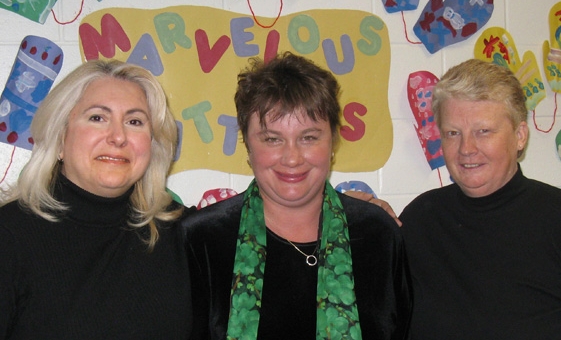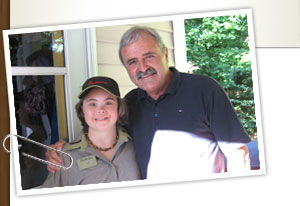Transition Plans
Transition planning, intended to help young people move from school to the adult world, is fairly standard in schools now. The degree of parental involvement in transition plans can make a great difference to their effectiveness. Good plans should not only focus on a job or living situation. Friendships and a social life should be an important part.

An Educator’s Initiative Inspired by a Parent
Linda Alonzi, a high school principal, saw an opportunity to create long-term relationships between some of the students in her school’s experiential program and their local elementary school communities. She was inspired by Kim, a former student who has for many years now been a valued full-time Kindergarten volunteer and has formed many relationships in the school. It was Kim’s mother who found this position for her daughter. Principal Alonzi has drawn together a group of colleagues from her Toronto Catholic District School Board to create the pilot program. Photo l-r: Linda, Kim and Liz, principal of Kim’s school.
(You can learn more about this program in An Innovative Pilot Project in the Educators section of this site: http://www.ibelong.ca/index.php/educators/transition-planning/an-innovative-pilot-project/)
1. School-led transition plans
Transition plans vary from board to board within provinces, but they usually have a set format, starting around grade 10 and being carried forward from year to year. They may include increasing degrees of involvement of the young person in the wider community—coop or volunteer placements and recreational opportunities where they learn social and work skills.
The transition plan that takes shape needs to be implementable, with clear steps and people designated and committed to carry through each step. There is little value in a planning meeting where no one is present who is going to implement the plan after the young person has left school! The planning meeting or meetings may take place during school hours, but do your best to attend and contribute to the meeting and ask one or two others from your family or your young person’s support network to attend with you. Families are often best able to judge whether the post-school part of the plan will work.
On the school’s side, more stakeholders than just the classroom teacher need to be involved. Educational assistants, the principal, and other resource people or professionals in your family member’s life should be part of this partnership. These people can do a lot to help teachers feel more supported and invested in the process.
Important: Good transition plans will be “person-centred” – that is, centered on the young person and on his or her abilities and aspirations. Keep in mind that although you and their educators have crucial roles to play, it is your family member’s future. Families need to make sure the transition planning process allows the young person to have a leading role and allows space for dreams. High expectations are not necessarily unrealistic. There may be multiple possibilities, whether post-secondary education (increasingly available), a job, supported living, volunteering, or community programs with social goals. Dream big! And allow your family member to do so.
My son made many friends in high school, but we moved after that and he has had difficulty in making friends that he can visit on his own or who are allowed to go visit on their own.
Tressa, BC
The tools themselves seemed to have all the potential for working, but none of the tasks or goals set were achieved because the programs did not follow through. Programs need to be monitored and program facilitators need to answer to someone or lose their licence when they fail to follow through with their promises. It needs to be recognized how people’s lives are affected by the dishonesty and negligence of program facilitators.
Parent, MB

Transitioning from School to Adult Life
“I would say keep your expectations moderate and recognize that transition itself is a process and not an event. It takes time as do so many other things with our children/students with disabilities. It also takes time for the community to get to know them and adapt to their particular needs. This has certainly been the case with our daughter. I also recognize the life-long role of advocacy that we parents inherit, especially when our sons and daughters leave school. Support (and respite) for parents is really important. Walking this walk alone is so very, very difficult and often depressing. So we need each other!”
Lock, BC
In this document, Dr. Gary Bunch emphasizes the importance of family-educator collaboration onthe transition planning that is often absent for young adults with disabilities.
Some of the young people who contributed to this website - Aine in BC and Kim in Ontario - attended post-secondary programs that they found helpful. This document provides several links to post-secondary opportunities and information for thinking about going on to college.
2. Other transition planning tools
MAPs (Making Action Plans) and PATHs (Planning Alternative Tomorrows with Hope) are planning tools developed by the Marsha Forest Centre, not by schools. A PATH meeting consists of a series of 8 structured questions and 3 or 4 hours are usually scheduled for the meeting. MAPs and PATHs are often preferred by families over school transition plans developed by educators. Teachers are usually less familiar with them and may be reluctant to adopt them because of the time demands—often evening meetings so all key people can be present. Social services tend to like them but can find them difficult to implement because much one-on-one time is usually implied.
Some of their attractive features:
involve what is known as ‘person-centred planning.’
involve family, educators, support workers, service providers and friends.
focus on creating a support network around the person with intellectual disabilities.
place emphasis on the person’s skills, interests, and aspirations.
use graphics and allow for dreaming—process can be exciting.
seek to create a team effort around developing a full life in community for the individual with an intellectual disability.
are results oriented.
Some Challenges:
PATHs and MAPs require a lot of effort and time on the part of all involved. They can thus be more challenging to implement properly.
There can be difficulty in getting sustained participation.
Sometimes a plan emerges that is unrealistic and disappointment ensues.
This document provides links to more information on various transition planning resources and organizations.
This document provides more resources and information for learning about and using Person-Centered Planning.


